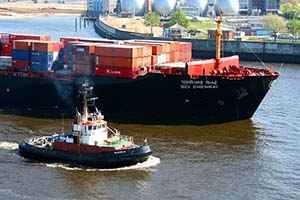Maritime gigantism: the race for profitability at the expense of safety
 For the time being, container ships are the backbone of world trade. These giants of the seas alone account for more than 60% of all shipping, which in terms of value, represents 14 trillion USD worth of goods transported in 2019.
For the time being, container ships are the backbone of world trade. These giants of the seas alone account for more than 60% of all shipping, which in terms of value, represents 14 trillion USD worth of goods transported in 2019.
In the same year, 863 million containers, accounting for about 2 billion tons of cargo, have transited from one port to another across the globe.
This evolution in value and volume is supported by the decline in shipping costs. Over the last ten years, the price of this type of freight has almost halved, while the price of road and air transport has remained stable.
With increasing globalization and intense competition, companies are more than ever looking for greater profitability through lower production and transportation costs. Container ships are thus becoming an essential link in the production chain.
This mode of transport is gaining more and more ground thanks to:
- an economy of scale achieved thanks to a significant reduction of costs in fuel, labor, …
- a loading capacity much higher than that offered by other means of transport: road, train, airplane. This capacity has gone fourfold in twenty-five years.
- a large number of ports that can be served on a single trip.
- the possibility of loading all kinds of goods: liquids, bulk, cars, livestock, …
- intermedullary: ability to transport goods from door to door within the same container.
Read also | Top 10 of the largest cruise boats
Constraints of maritime gigantism
Despite these important developments, maritime gigantism showcases many shortcomings.
- Ships, being too large, become very difficult to maneuver,
- The slowness of container ships. To reduce fuel loads and improve their profitability, shipowners are slowing down the velocity of their ships. The Europe-China round trip is completed in ten weeks instead of eight with an average speed reduced to 19 knots (35 km/h),
- Fewer and fewer ports are big enough to accommodate these outsized ships, with many port basins being too small to allow these vessels to maneuver and dock. Some countries, particularly in Asia, are now planning on developing their ports, for instance, Hong Kong, Shanghai (China) or even Busan (South Korea),
- Land infrastructures (storage areas, port equipment, ...) are sometimes not suitable enough to allow ship loading and unloading in good conditions,
- The mooring of a single container ship of this type, 350 to 400 meters long lengthens the waiting time for other ships,
- Container loading and unloading time is longer: unloading a container ship of more than 22 000 TEU requires several days of work,
- Some routes have to be permanently adapted to ensure the passage of these behemoths: Suez Canal, Panama Canal, …
- Pollution and ecological impact. Several thousand containers, which may contain toxic products, end up at the bottom of the oceans every year,
- A greater risk of grounding. No less than seven accidents have been reported between October 2020 and February 2021 in addition to the Ever Given incident in the Suez Canal at the end of March 2021,
- Colossal financial losses in case of grounding or incident.
Read also | Container ships: main accidents
Maritime gigantism: risks related to the accumulation of value
 A 20 000 TEU container ship carries an average cargo value worth around 1 billion EUR. In addition to this amount, the damage to the vessel itself can reach up to 200 million USD in the event of total loss of the hull.
A 20 000 TEU container ship carries an average cargo value worth around 1 billion EUR. In addition to this amount, the damage to the vessel itself can reach up to 200 million USD in the event of total loss of the hull.
In the event of a major incident, the accumulation of such values on a single vessel can trigger heavy losses for marine insurers. Moreover, the evaluation of the damages, which can last several years, is a real headache for the profession. Indeed, this operation is designed to look into certain elements such as:
- the determination of responsibilities,
- the evaluation of losses related to the interruption of the supply chain,
- the estimation of the lost revenues to be sustained by the different actors involved in the marine transport chain.
The constraints associated with gigantism and the accumulation of values pose a crucial problem of insurance coverage, especially in view of the high risk of fire.
Fire risk on board container ships
Fire is the most significant hazard dreaded by container ships. The frequency and severity of this type of loss reached an all-time high in 2019.
According to the 2020 Annual Maritime Safety Report published by Allianz, no fewer than 40 fires were reported in 2019, an average of one every 10 days.
While in fifty years, ship size has tripled and capacity has been multiplied by 16 (from 1500 TEUs in 1968 to 24000 TEUs today), safety equipment, particularly firefighting equipment, has barely evolved.